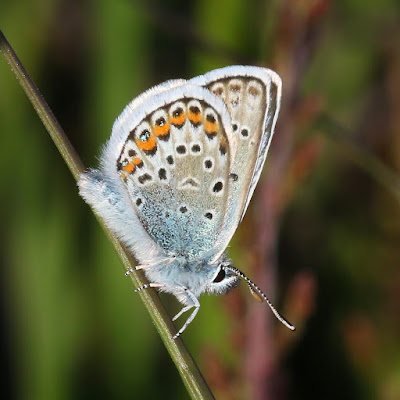Work and leisure have involved a fair bit of travelling lately - not exactly to the ends of the earth, but opposite corners of England at least, from Kent to Cumbria within the course of last week. Kent was a work engagement, speaking to the
Kent Nature Partnership about some research we commissioned in Dorset to illustrate
the importance of a healthy environment to a successful economy. A lovely audience, who laughed at my bad jokes and murmured appreciatively at all the right moments. It was good to be back and catch up with some old friends, including the Kent Wildlife Trust boss John Bennett.
 |
| Heath Fritillary - a fresh male |
 |
| A full-bodied female |
 |
| The striking underwing pattern of a roosting Heath Fritillary |
 |
| Another roosting individual, bathed in sunshine |
Whilst there, I found time to squeeze in a visit to one of John's reserves, East Blean Woods, which plays host to one of our rarest and most attractive butterflies, the Heath Fritillary. Reassuringly, good numbers were on the wing. The speaking engagement (at the stately University of Greenwich campus in Medway) was also just around the corner from the hedgerow chosen by a long-staying male Red-backed Shrike - not something you see every day - so I managed a peek at that too on the way home.
 |
| Heath Fritillary: an eye-catching aberration |
 |
| C'mon folks, get a room... |
 |
| Male Red-backed Shrike: a mobile bird which came reasonably close at one point |
 |
| A male Red-backed Shrike is a very dapper bird |
Last weekend saw us heading up the M6 to the other corner of our green and pleasant land for a family gathering to mark my big brother's 50th. He was down from Clackmannanshire, parents up from Devon, and sis up from Brighton so it was quite a logistical feat to get us all in the same county let alone the same room. An idyllic setting in the Lake District was a bit damp for much in the way of wildlife watching - though 48 hours with my extended family provided plenty of opportunity to study animal behaviour...
|
|
| House Martin picking food items off the tarmac in the Lake District |
 |
| Peregrines at Warton Crag |
 |
| Ringlet at Warton Crag |
 |
| Ringlet underside |
A brief stopover just off the M6 on the way home in Lancashire did enable me to see my first Northern Brown Argus for over a decade on the limestone crags above Warton, as well as some newly fledged Peregrines on the wing. With just a month to go before
Hen Harrier Day 2016, at least one pair of northern raptors have survived the attentions of their persecutors.
 |
| Northern Brown Argus, Warton Crag |
 |
| Northern Brown Argus nectaring on bramble |
 |
| Northern Brown Argus underside |
 |
| A backlit Northern Brown Argus at Warton Crag to end a flying visit to the north west |































































